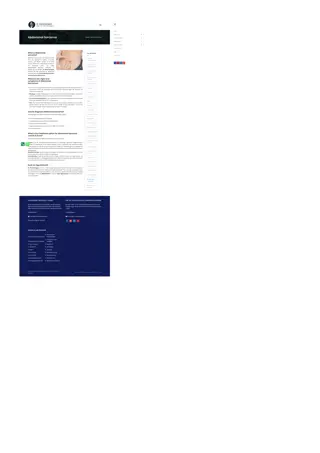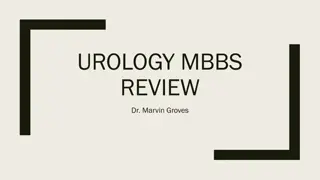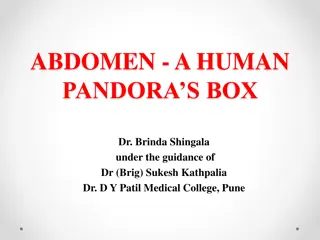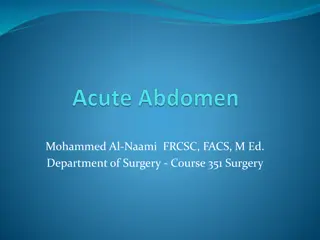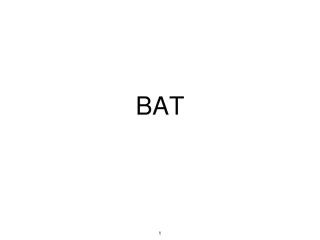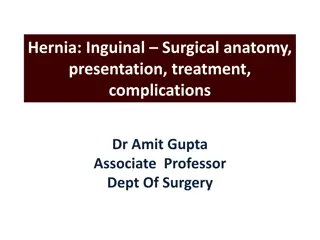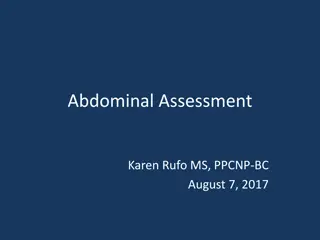Comprehensive Guide to Abdominal Assessment for Healthcare Professionals
This lecture by Hassanain Mohammed Kadhim covers the essential techniques and subjective data needed for a thorough abdominal assessment. It includes objectives, equipment required, preparation steps, subjective data collection, inspection guidelines, abdominal landmarks, common causes of abdominal distension, and more. The content provides a detailed overview for healthcare students on safely and accurately conducting abdominal assessments.
- Abdominal Assessment
- Healthcare Education
- Hassanain Mohammed Kadhim
- Subjective Data
- Inspection Guidelines
Download Presentation

Please find below an Image/Link to download the presentation.
The content on the website is provided AS IS for your information and personal use only. It may not be sold, licensed, or shared on other websites without obtaining consent from the author. Download presentation by click this link. If you encounter any issues during the download, it is possible that the publisher has removed the file from their server.
E N D
Presentation Transcript
ABDOMINAL ASSESSMENT Hassanain Mohammed Kadhim Lecture -9-
Objectives: At the end the students will be able to: 1 .Demonstrate the ability to safely & accurately complete abdominal assessment. 2.Demonstrate the ability to accurately document abdominal assessment data in organized manner. Equipment Needed I. Stethoscope. 2.Measuring tip centimeter. 3.Skin-marking pen. 4.Alcohol swab (to clean end piece).
Preparation 1 .Expose the abdomen so that it is visible. 2.Drape the genitalia & female breast. 3. Ask the client to empty the bladder. 4.Keep the room warm. 5.Position the client supine, with the head on a pillow, the knees bent or on pillow, & the arm at the sides or cross the chest. 6.Warm the stethoscope end piece. 7.Warm your hand. 8.1nsure about any painful area, examine such area last to avoid any muscle guarding. Note: Assessment of abdomen different from other assessments in that inspection & auscultation precede percussion & palpation.
Subjective data: 1. Dysphagia (Difficulty in Swallowing) 2. Nausea and vomiting 3. Food intolerance 4. Bowel habits 5. Past abdominal history 6. Medications 7. Nutritional assessment 8. Appetite 9.Abdominal pain
ABDOMINAL ASSESSMENT 4 technique 1-Inspection 2-Auscultation 3-Percussion 4-Palpation 5 M.Sc Hassanain Mohammed Kadhim
ABDOMEN LANDMARKS 6 M.Sc Hassanain Mohammed Kadhim
-7- F CAUSE ABDOMINAL DISTENSION 1- Fat (obese) 2- Fluid ( Ascites) 3- Flatus ) 4- Fetus 5- Feces (Constipation) 6- Fatal Growth ( malignancy ) 7- Fibroid Tumor Gases) Pregnancy) ) 7 M.Sc Hassanain Mohammed Kadhim
Inspection: 1- Color ; normal light 2- Contour ( shape): flat or slightly rounded Ab: scaphoid & distension 3- Symmetry : symmetrical ( when client supine position raise his head) Ab: Asymmetrical caused by organ enlargement , mass , hernia 4- Respiratory movement : can seen clearly in male 5-Aortic pulsation : no pulsation seen or slight pulsation in the epigastric region in thin people
6- Peristaltic waves: no waves will be visible may be seen in thin person Ab: ripple form waves may seen in the intestinal obstruction 7- Inspect for lesion and rash: free on lesion and rash Ab: change in mole , petechiae Striae : free of striae , silver to white color striae may seen in obese or multigraveda 8- Vascularity : fine veins may seen located above or blow the umbilical area Ab: @ dilated vein seen in liver cirrhosis , obstruction of inferior vena cava , portal hypertension or ascites @ spider angioma : dilated artery or capilliary in portal hypertension and liver disease
9- Scar : free of scar Ab: assess scar according to location , size and color (young scar is pink while old scar is white) Spider Angioma
10- Umbilicus inspect for the following : A- Color : pink skin around it should be evenly as abdomen color Ab: bluish around umbilicus ( cullen s sign) intra - abdominal bleeding B- shape inverted or protruded not more than 0.5 cm Ab: everted in abdominal distension or hernia C- Location : midline at lateral line Ab: deviated umbilicus caused by mass , scar , hernia
Auscultation of abdomen for the following: Bowel sounds Use the diaphragm of a warm stethoscope Apply light pressure to auscultation bowel sounds for up to 5 minutes in each quadrant. Begin in the right lower quadrant (RLQ) at the ileocecal valve area Assess for frequency and pitch
Normal bowel sound: soft clicks and gargling heard in 5-30 per minute . Loud prolong gurgle of stomach growling hyperactive sound called ( borborygmi ) Ab: Hypoactive bowel sound in diminished motility in surgery , late bowel obstruction Hyperactive bowel sound occur by diarrhea gastroenteritis or early bowel obstruction Absent bowel sound associated with peritonitis or paralytic ileus
Vascular sound use the bell to auscultate for vascular Sounds normally: No bruits, no venous hums, no friction rubs. Assessed in the following area: Right renal artery Left renal artery Right iliac artery Left iliac artery Right femoral artery Left femoral artery Aortic hum Umbilical hum
Percussion of the abdomen for the following: 1- General percussion 2- Liver span - percuss starting below umbilicus at client's right midclavicular line (MCL). - Percuss upward until you hear dullness; mark this point. - Percuss downward from the lung resonance in the right MCL to dullness & mark. - Repeat in midsternal line. 3- scratch test to assess liver
6-SPECIAL TEST ( ASCITES ) Ascites; Accumulation of Fluid in the Peritoneal Cavity 1- Shifting dullness 2- Fluid wave test
7-ASSESS APPENDICITIS 1- Rebound Tenderness 2- Rovsing Sign 3-Positive Psoas Sign 4- Positive Obturator Sign










